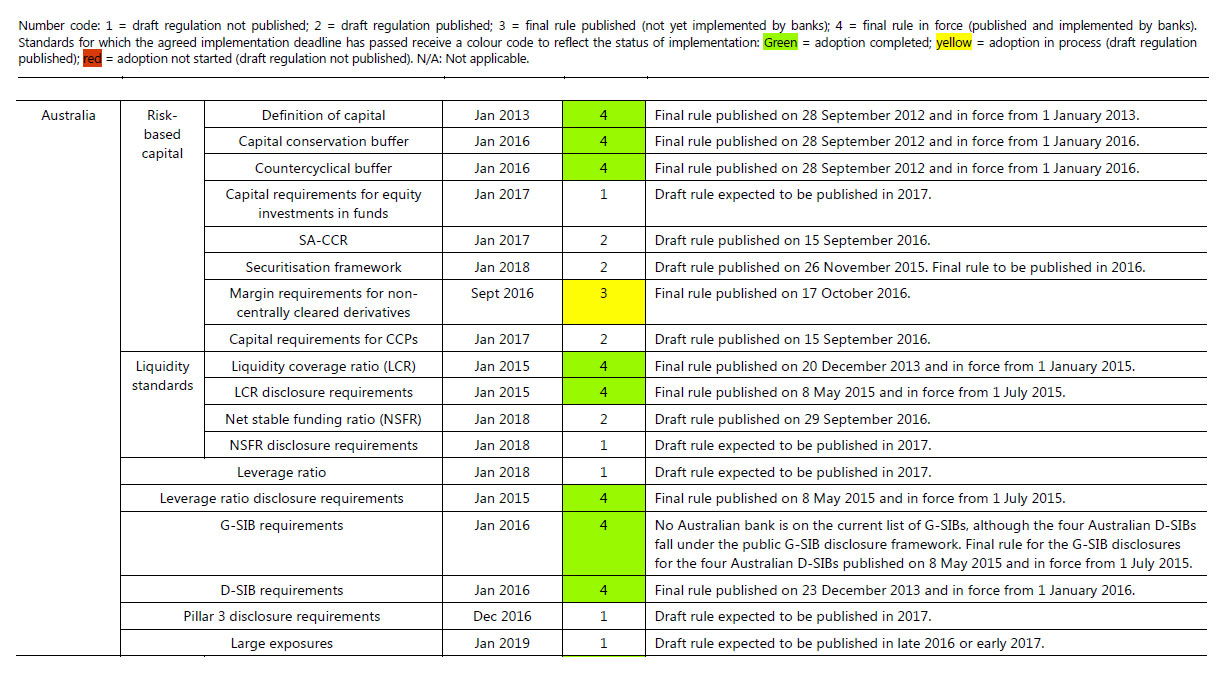The Basel Committee on Banking Supervision has issued the Eleventh progress report on adoption of the Basel regulatory framework. It includes a status update for each country, including Australia, where progress continues, based on self-reporting made to the committee in March 2016.
Pillar 3 disclosures appear to be the main area of slippage. In January 2015, the Basel Committee issued the final standard for revised Pillar 3 disclosure requirements, which will take effect from end-2016 (ie banks will be required to publish their first Pillar 3 report under the revised framework concurrently with their year-end 2016 financial report). The standard supersedes the existing Pillar 3 disclosure requirements first issued as part of the Basel II framework in 2004 and the Basel 2.5 revisions and enhancements introduced in 2009.
 More broadly, the Committee’s latest report as of end-September 2016 shows that:
More broadly, the Committee’s latest report as of end-September 2016 shows that:
all 27 member jurisdictions have final risk-based capital rules, LCR regulations and capital conservation buffers in force;
26 member jurisdictions have issued final rules for the countercyclical capital buffers;
25 have issued final or draft rules for their domestic SIBs framework; and
18 have issued final or draft rules for margin requirements for non-centrally cleared derivatives.With regard to the global SIBs framework, all members that are home jurisdictions to G-SIBs have the final framework in force. While members are now turning to the implementation of other Basel III standards, including the leverage ratio and the net stable funding ratio (NSFR), some member jurisdictions report challenges in meeting the agreed implementation deadlines for some standards. These include the revised Pillar 3 framework (by end-2016), the standardised approach for measuring counterparty credit risk (by January 2017), capital requirements for central counterparty (CCP) exposures (by January 2017) and capital requirements for equity investments in funds (by January 2017).
This report sets out the adoption status of Basel III standards for each member jurisdiction of the Basel Committee as of end-September 2016. It updates the Committee’s previous progress reports which have been published on a semiannual basis since October 2011 under the Committee’s Regulatory Consistency Assessment Programme (RCAP).
Since it introduced the RCAP in 2011, the Committee has periodically monitored the adoption status of the risk-based capital requirements. From 2013, the Committee expanded its coverage to monitor its members’ adoption of the requirements for systemically important banks (SIBs), the liquidity coverage ratio (LCR) and the leverage ratio. In 2015, the Committee extended its monitoring of the adoption progress to all Basel III standards, which will become effective by 2019.
Methodology
The information contained in the following table is based on responses from Basel Committee member jurisdictions, and reports the status as of end-September 2016.
The following classification is used for the adoption status of Basel regulatory rules:
1. Draft regulation not published: no draft law, regulation or other official document has been made public to detail the planned content of the domestic regulatory rules. This status includes cases where a jurisdiction has communicated high-level information about its implementation plans but not detailed rules.
2. Draft regulation published: a draft law, regulation or other official document is already publicly available, for example for public consultation or legislative deliberations. The content of the document has to be specific enough to be implemented when adopted.
3. Final rule published: the domestic legal or regulatory framework has been finalised and approved but is still not implemented by banks.
4. Final rule in force: the domestic legal and regulatory framework has been published and is implemented by banks.
In order to support and supplement the status reported, summary information about the next steps and the adoption plans being considered are also provided for each jurisdiction.
In addition to the status classification, a colour code is used to indicate the adoption status of each jurisdiction. The colour code is used for those Basel components for which the agreed adoption deadline has passed.Green = adoption completed; yellow = adoption in process (draft regulation published); red = adoption not started (draft regulation not published). N/A: Not applicable.
